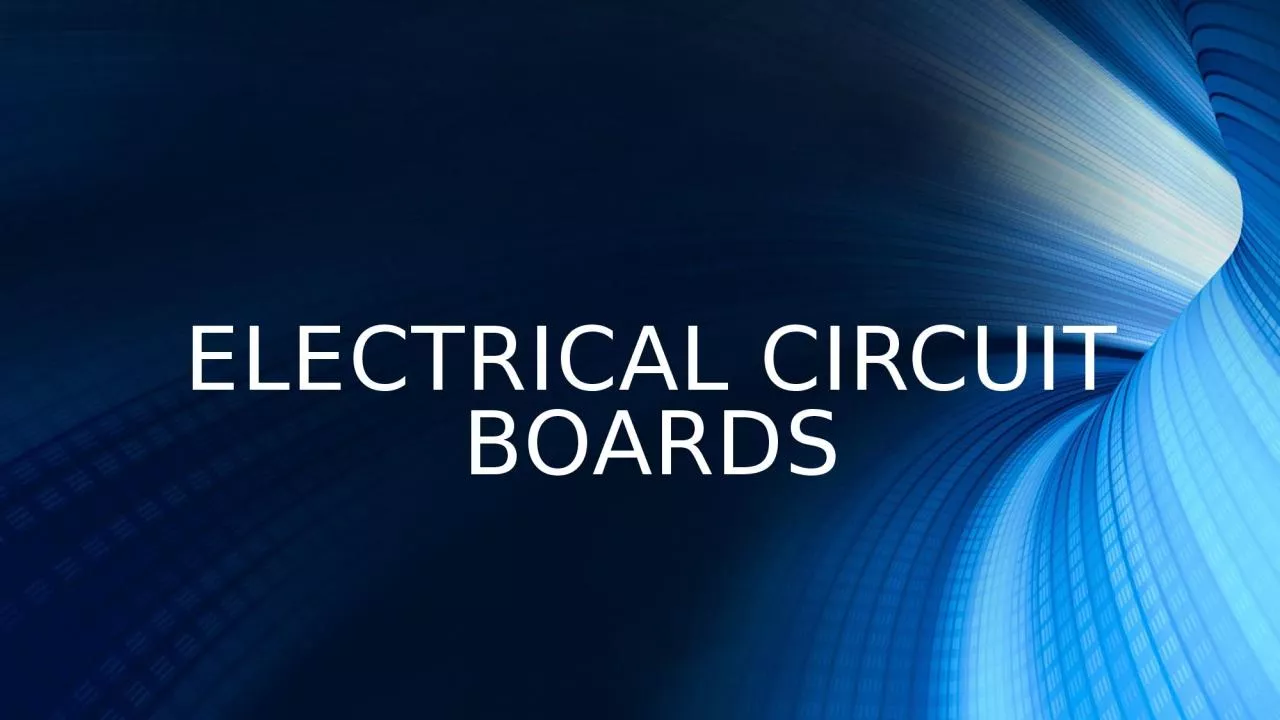

SYMBOLS OF THE COMPONENTS Cells in series amp parallel An open amp closed switch An ammeter A voltmeter Resistors in series amp parallel Bulbs in series amp parallel A variable resistor ID: 1031045
Download Presentation The PPT/PDF document "ELECTRICAL CIRCUIT BOARDS" is the property of its rightful owner. Permission is granted to download and print the materials on this web site for personal, non-commercial use only, and to display it on your personal computer provided you do not modify the materials and that you retain all copyright notices contained in the materials. By downloading content from our website, you accept the terms of this agreement.
1. ELECTRICAL CIRCUIT BOARDS
2. SYMBOLS OF THE COMPONENTSCells in series & parallelAn open & closed switchAn ammeterA voltmeterResistors in series & parallelBulbs in series & parallelA variable resistor
3. Draw the following circuit: Three cells are connected in series with a closed switch. An ammeter in series has a reading of 10A. The voltmeter across the battery is 24V. Two bulbs are connected in series with three resistors in parallel.
4. Potential DifferenceThe chemical reaction comes from a chemical reaction which takes place inside the cell.The electrical energy produced is measured in VOLTS.Cells have a potential difference (voltage) marked on the side. It is the potential difference across the terminals of the cell.It is a measure of the amount of potential energy stored in the cell.
5. The higher the voltage of the cell the more energy the electrons have available to pass along the conductors in the cell.We measure the voltage of the cell by connecting a VOLTMETER across its terminals.We also get a potential difference over any resistors in a circuit.
6. How to calculate Potential Difference (series and parallel)
7. V = W / QPotential difference measured in volts (V)Work done (ENERGY) measured in Joules (J)Amount of charge measured in Coulomb (C)
8. 120J of work is done in lighting a bulb when a charge of 20C flows through it. What will the potential difference be across the bulb?How much energy is transferred when a 60V source allows a 6C charge to flow through a conductor?
9. Electrical CurrentElectric current strength is the rate which electric charge flows in a circuit.A source of electrical energy (cell / battery) is necessary for an electric current to flow.
10. A circuit travels from the negative pole to the positive poleThe symbol for current is “I”The unit is AMPERE (A)
11. Current is measured with an ammeter. The positive terminal of the ammeter is connected so it is closest to the positive terminal of the battery.An ammeter is connected in series.
12. I = Q/tCharge Measured in Coulombs (C)Current Strength Measured in Amperes (A)Time Measured in seconds (s)
13. How much current is flowing when 10C of charge moves past a point in 5S?
14. What is the current strength in a circuit if 50C moves past a point in 2 minutes?In 5 seconds the current run at 1.2A. What is the charge in the circuit?In a circuit that has 360C, the current is 36A. Calculate the time it would take for the current to pass.It takes 10 seconds for 55C of charge to circulate. What is the current strength?
15. RESISTANCEResistance is the ability of a component in an electrical circuit to oppose the flow of current.Examples of resistors include the filament in a light bulb and the element in the kettle.
16. A conductor is a material that allows electric current to flow through it, but even it offers some resistance.The amount of resistance a conductor offers depends on: The temperature of the conductor. The length of the conductor The width of the conductor The material the conductor is made out of
17. ResistorsA resistor is a component that opposes the flow of electric current in an electrical circuit.
18. Resistors provide useful energy transferResistors are used to control the flow of current in an electric circuit and they provide useful energy transfer.Example: The element in an electric kettle turns electrical energy into heat energy in order to boil water.
19. Variable resistorsSome resistors can change the value of the resistance offered – like a dimmer light switch.We call these variable resistors or RHEOSTATS
20. A light-dependent resistor (LDR) is sensitive to the amount of light shinning onto it. Normally has high resistance in the darkExample: lights that turn on and off automatically depending on the amount of light around.
21. DIODESA diode is an electrical component that controls the flow of current in a particular direction. In one direction it offers a high resistance and in the other direction it offers a low resistance.EXAMPLE: LED traffic lights
22. RESISTORS IN SERIESResistors in series: Rs = R1 + R2 + R3Measured in OHMS (Ω)When resistors are connected in such away that there is only one path through which the current can flow the resistors are connected in series.
23. RESISTORS IN PARALLELLet me show you…